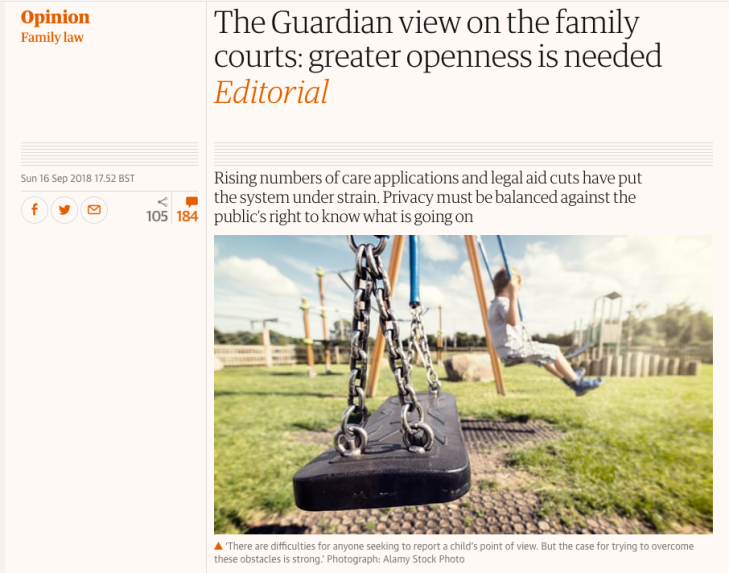This is the first blogpost launching my new project, The Open Family Court, which has been generously funded by the Paul Hamlyn Foundation Ideas and Pioneers Fund.
The project is planned as a collaborative exploration of how to recalibrate the balance between privacy in family courts – which exists for the very good reason of protecting vulnerable children – and freedom of expression, which allows people to speak out publicly about what the state has done to them, a right currently hobbled by the Administration of Justice Act 1960.
To realise the project’s full potential – I’m thinking of it as a quest for a solution to a so-far-intractable-but-not-impossible conundrum – I’m going to need all the help and engagement I can get from people with knowledge and experience of family law, children’s services and the family court system.
This is therefore an introductory scoot through the background to this project and the reasons for it (having just read it back, it may not feel like a scoot, but I promise I have slashed the post back to the bare bones of what I think needs saying, and am very grateful to anyone who stays the distance!)
* * *
Section 12 of a nearly 60 year old piece of legislation means that anyone who describes or publishes what happens in front of a family judge risks being in contempt of court. The sanction is a fine or jail – possibly both.
The result is that if people working in the family law system – social workers, expert witnesses, children’s guardians, lawyers and judges – act unprofessionally, unethically or even unlawfully, unless a judge says it’s okay to talk about it, or a judgment is published (and the judge is the sole arbiter of what goes into that), nobody is allowed to know.
It means there is little effective scrutiny or accountability in our family courts.
It means that parents cannot protest their treatment at the hands of the state – and when you stand to lose your children, sometimes for ever, this is an extraordinary loss of your human right to freedom of speech; the very opposite of open justice.
It means that although for the most part, since 2010 journalists have been able to attend family courts, we cannot, by right, report the detail of what goes on in them – and so we can’t do our job as the eyes and ears of the public when extraordinary intrusions into family life are made and draconian actions that change people’s futures are taken by the state.
It means that citizens are prevented from knowing what is being done in their name.
Given the journalism I’ve done on issues highlighted in judgments that illustrate poor practice, professional failure, deliberate thwarting of court orders and actual human rights abuses – and the telling details I have not been able to report in cases I’ve personally observed because of these statutory reporting restrictions – I am convinced that children would be better served by a family law system that has to work with something at least approaching the degree of transparency required of the rest of our justice system – required indeed of those working across both other arms of the state.
Before I go on to explain more about my plans for The Open Family Court over the next nine months, I thought I’d recount a few experiences from my time as a journalist reporting on some of the most distressing and extraordinary events I’ve ever encountered. At the same time, they are commonplace, and endured by many people, right across society. That’s what makes family law relevant to everyone. And why it matters so much how it’s done.
* * *
Three and a half years ago I pitched up at the big central family court in Bristol. I was researching a Guardian feature about cuts to legal aid for domestic abuse victims and my editor wanted me to report on what it was like for a woman trying to get a non-molestation order on her own, without a lawyer to represent her.
I’d never been to a family court before. Thanks to a hurried reading of a guide I knew there were statutory restrictions on what I’d be able to write. What I didn’t realise at the time was just how hard it would be to get them relaxed. (I also had no idea how family courts worked. It turns out there are specific “non-mol” days where these applications are heard and unfortunately I hadn’t arrived on one of them.)
For the next story I did on how legal aid cuts were affecting separating parents who were in dispute about their children, I thought I’d try asking for permission to report. Naively, I now realise, I whizzed off an email to the district judge with a polite request to let me describe what had gone on in court in a private law case I’d just observed.
Everyone would be anonymous, I promised.
Equally politely, he replied saying I’d need make a formal application – costing £155 I seem to recall – and a skeleton argument (a what? I really had no idea, but it certainly sounded like it was going to take quite a lot of time and money.)
He also asked if I had informed the the parties to the case – the mother, father and the Cafcass guardian – of my wish to write about it. They would all need to formally tell the court their view of me reporting, even anonymously, what I’d witnessed.
I groaned. Given the price tag attached to submitting a formal application (I wasn’t at all convinced I’d get it through on expenses), my lack of legal expertise or any experience of writing skeleton arguments, the inevitable acrimony between the parents involved, and most of all the timescales – journalists work to deadlines after all, and I could tell this would all take an age – doing as the judge required was a practical impossibility.
So I wrote my article with my heart in my mouth, trying to skirt around the most interesting and importantly, informative moments in court that illustrated perfectly the immense disadvantages to the father, in that particular instance, of not being able to afford a lawyer. Even so, I had sleepless nights in the lead up to publication wondering if I would be in contempt.
Since then, I have made one oral and two written applications to relax reporting restrictions in public law care cases. All were successful, but the immense amount of work entailed in the written applications – in one, about a North Tyneside woman whose son was removed at birth and her fight to get him back, this ultimately comprised eight days of pro bono support from two barristers, countless hours of my own time and an expense claim that took my editor’s breath away – means such an effort is simply impossible except for very important stories.

“Annie” and her son in North Tyneside, by Christopher Thomond for The Guardian
As a freelance, what I was paid for the resulting articles didn’t begin to reflect the work or time required to get the right to publish them. Other journalists have made similar efforts: after taking considerable pains to get permission to report a case she’d seen at Birmingham’s family court, Buzzfeed UK’s senior reporter Emily Dugan’s view was that:
“Journalists are bound by their own ethics, and also strict laws on anonymity. Judges could do more in hearings themselves to make orders on the hoof to make it clear what the journalist can and can’t report, after hearing brief arguments. Anything more costly or time-consuming than that feels more prohibitive than court reporting should be in a democratic country.”
* * *
On my desktop at home, I have a email folder where I file all the many messages I’m sent by parents who say their children have been removed unfairly. They detail not only the heartbreak and fury, but also the sense of injustice they feel at a system they believe is stacked against them and which in some cases, they say, has seen professionals behave unlawfully in breach of their human rights.
Whatever the rights and wrongs of each complaint – and resource-wise is it impossible for me to investigate almost any of them – it has become very clear there is an upswell of distrust in local authority children’s services in general and in social workers in particular.
The fact that nobody is legally permitted to speak publicly about the evidence given about them in court, and how the processes can – and demonstrably have in some cases where judgments are published – unfairly disadvantaged families, significantly compounds people’s rage and indignation.
It’s obvious why: imagine the state removes your child and has it adopted without your consent. Then imagine you’re told you can’t complain about a legal process that you feel has been handled unfairly, even unlawfully. Outrage is piled upon grief when families can’t protest their treatment at the hands of the state. Families are, by law, rendered voiceless and so end up powerless to challenge and change a system which they – with varying degrees of justification no doubt, but sometimes entirely correctly – believe is shockingly unjust.
And so mistrust grows, and families that need help don’t believe they can risk asking for it. Vulnerable children then end up at greater risk… and the cycle implodes upon itself, trailing ever greater destruction in its wake.
* * *
Back to the Open Family Court.
This project follows and takes inspiration from a significant evolution in thinking about transparency in the family courts that has taken place over the past several years.
The dilemmas around transparency were already being articulated in 2011 when the then president, the late Sir Nicholas Wall, wrote in his preface to the abovementioned media reporting guide:
“There is no more difficult issue in family justice than the reporting of cases. There is a tension between concerns about “secret justice” and legitimate expectations of privacy and confidentiality for the family. Both standpoints are valid, and the question is whether they are irreconcilable.”
Sir Nicholas went on to say that the publication of the guide –
“…is all the more timely as the debate on increased transparency and public confidence in the family courts moves forward. It will serve to inform future consideration of this difficult and sensitive area, including the questions of access to and reporting of proceedings by the media, whilst maintaining the privacy of the families involved.”
Real progress towards greater openness and understanding of what happens in family law was propelled by the subsequent 2014 practice guidance issued by the immediate past president Sir James Munby, telling circuit judges and those more senior that they must, unless there are compelling reasons to the contrary, publish their judgments in family cases.
That followed his previous year’s “View from the President’s Chambers”, in which Sir James said he was:
“determined to take steps to improve access to and reporting of family proceedings. I am determined that the new Family Court should not be saddled, as the family courts are at present, with the charge that we are a system of secret and unaccountable justice.”
I have argued before that while this is a big step forward, it is nothing like enough to ensure proper scrutiny and accountability in our family courts.
As a journalist, I don’t want to have to rely for my reporting on what a family judge says in her judgment: in no other situation do I take any arm of the state at its word without the opportunity to evaluate its account against those of others who have been involved. And in any case, recent research has shown that in some areas of the country, judgements just don’t see the light of day.
Also… what if a judge behaves badly? What if she gets things wrong? It happens. Why shouldn’t we know?
And if I was a family member involved in a private or public law case, I’d want to have the choice to give my own account of the process by which life-changing decisions were taken about my family’s future.
It’s important to note here that when asked to relax statutory reporting restrictions, judges have often agreed, at least in part. I’ll give a couple of examples.
- After barrister Lucy Reed and I worked together on a way to anonymise the North Tyneside family that was both editorially acceptable and addressed the concerns of the council, in 2015 Mr Justice Bodey published his judgment allowing me to report using the name of the council in question, and quoting from the case papers (which Judge Simon Wood had earlier allowed me sight of, against the wishes of the local authority). I did not seek to name the family. This is important, and a point I will return to in later posts.
- Against the council’s wishes, Judge Stephen Wildblood last year allowed a joint application by me, Buzzfeed UK and BBC Gloucestershire to name Gloucestershire county council in a case where a special guardian wished to make clear her dismay at how her family had been dealt with. We did not seek to name the family.
- In 2013, Sir James Munby, president of the family division, in a case which he said “raises important questions about how the court should adapt its practice to the realities of the internet, and in particular social media,” allowed a father to freely publish a video of his one day old baby, who had been removed from his care, while at the same time restricting the publication of the child’s name.
* * *
It is clearly not going to be easy to find a way through the dilemma of how to enhance transparency and openness in family courts while still ensuring children’s privacy, but I believe there are huge strides that can safely be made.
Not least, changes are needed within the cultures of social work and family law. Despite some fabulous thinking that’s now being done [declaration of interest: I am a member of The Transparency Project, a charity which seeks to promote openness and understanding of family law and whose legal and academic members spearhead many of the discussions in this field] these are professions that often seem chary of any light being shone on their daily working practices in and around family courts.
My plan is to run a series of consultative events and workshops over the next nine months, drawing on the knowledge, experience and insights of family members, care leavers, social workers, adopters, foster carers and legal professionals who may already be engaging with these issues in their personal or professional lives, via blogs or on social media.
Through facilitated sessions, I’m hoping to create an environment where we can challenge and creatively disrupt existing ways of thinking about privacy and free speech in family cases; unpick seemingly intractable problems to work out what they consist of today, as opposed how they looked nearly 60 years ago; and generate thoughtful and safe solutions to a conundrum caused by a law that many feel is no longer fit for purpose.
So… it all kicks off properly in September. Anyone who would like to take part – there will be cake…

… and more importantly, some travel expenses are available for family members who may find it hard to afford the cost of attending.
If you’d like to get involved, please email me at openfamilycourt@gmail.com – if you could explain your interest in the issue, that would be brilliant, and I look forward to hearing from you!
Louise



